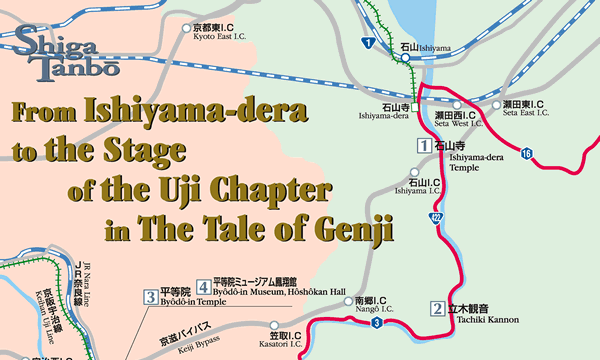
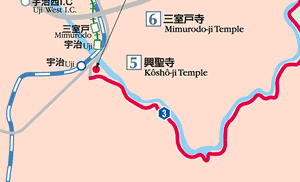
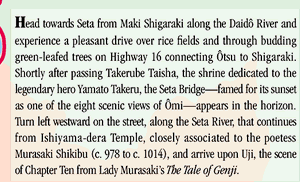

 |
|
 |
 |
|
This temple was built in 749, when Emperor Shômu (701-756; r. 724-749) was undertaking the construction of the great Buddha of Tôdai-ji Temple in Nara. Praying for the discovery of gold, the emperor asked the Kegon priest Ryôben (689-773) to build Ishiyama-dera to enshrine an image of Nyoirin Kannon. In the Heian period (794-1185), this temple became a popular pilgrimage site among the courtiers, and Lady Murasaki herself was said to have been confined for seven days to conceive The Tale of Genji here. The Main Hall, designated a National Treasure, was built upon a great megalith, which contributes to the temple’s fame as one of the eight scenic views of Ômi, the Autumn Moon from Ishiyama-dera. |
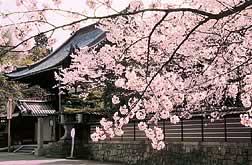 |
|
|
||
|
From Ishiyama-dera, head south on Route 422. About two kilometers passed the Nangôaraizeki Dam, on the western banks of Seta River, where the current becomes strong, you can see stone steps leading up to the Tachiki Kannon temple at the foot of Mount Tachiki. |
||
|
|
||
|
Formally known as Tachikisan An’yô-ji, this temple has attracted the devotion of many. Enshrined here as the main image of worship is a life-sized statue of Kannon, believed to have been carved from a single tree by the founder of the esoteric Shingon sect, Kûkai (774-835). Climb 670 steep steps to the Main Hall, located half way up the mountain.
|
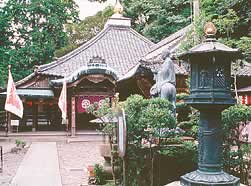 |
|
|
||
|
Head towards Shigaraki on Route 422, about 500 km from
Tachiki Kannon, and cross the Shishitobi Bridge. To go to Uji, change to
Regional Highway 3 (Ôtsu-Nangô-Uji Route). Seta River will be on the left.
After crossing the Sotsuka Bridge, an amazing natural scenery will come into
view on the right. |
|
|
|
|
|
In 1052, Regent Fujiwara Yorimichi (992-1074) turned his father Michinaga’s (966-1027) villa into a temple, which we know today as Byôdô-in. The enchanting Phoenix Hall was built in 1053 as the Amida Hall, which enshrines a large seated image of Amida Buddha, carved by the renowned sculptor Jôchô (d. 1057). The beautiful garden and hall that represent the Pure Land in the Western Paradise was designated a World Heritage Site in 1994. |
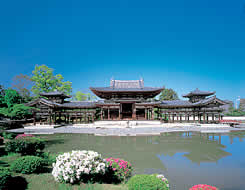 |
|
|
|
|
Hôshôkan Museum was opened in March 2001 to replace the former repository of Byôdôin, which was built in 1965 to house and display the treasures of the temple. In addition to exhibiting works of art designated as National Treasures, such as the temple bell and phoenixes, the latest digital technology is used to create a virtual eco-museum. |
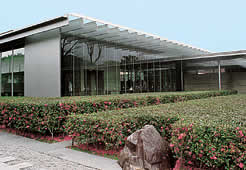 |
|
|
||
Take a leisurely stroll away from Byôdô-in. Cross the Asakiri Bridge and walk upstream against the flow of Uji River. After passing the Kanryû Bridge, the temple gate of Kôshô-ji will appear on the left side. |
||
|
|
||
The gently inclining temple path, known as Kotozaka (Zither Slope), is a popular scenic area in spring and autumn. Kôshô-ji was originally built in Fukakusa by the Sôtô Zen master Dôgen (1200-53). Later, it was destroyed and rebuilt in its present location by the lord of Yodo Castle, Nagai Naomasa (n.d.) in 1648. This quiet precinct must have been favorable to Naomasa, who was also a tea aficionado. The temple’s central image from the mid-Heian period (794-1185) is commonly known as Tenarai Kannon, because it was originally enshrined in the historic Tenarai Forest. |
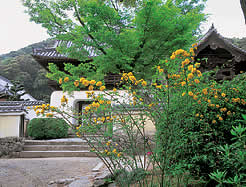 |
|
|
||
Uji has many historical and cultural sites. As the stage of Chapter Ten from The Tale of Genji, it became popular among the cultured who traced the places that appeared in this early novel. Our last stop is historic Mimurodo-ji Temple, which served as the scene for Genji’s Ukifune Chapter.J |
||
|
|
||
Mimurodo-ji, which has gathered a popular following, is the tenth stop on the thirty-three pilgrimage sites of western Japan. The temple is also popularly known as the ”Temple of Flowers” (Hana no Tera). Along the approach to the temple are 10,000 azalea trees and 5,000 hydrangea trees, which will be in full blossom in spring. Filled with many works of art from the Heian period (794-1185), the Treasure House is known for its standing image of Shakyamuni Buddha. |
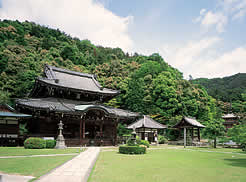 |
|
|
||
